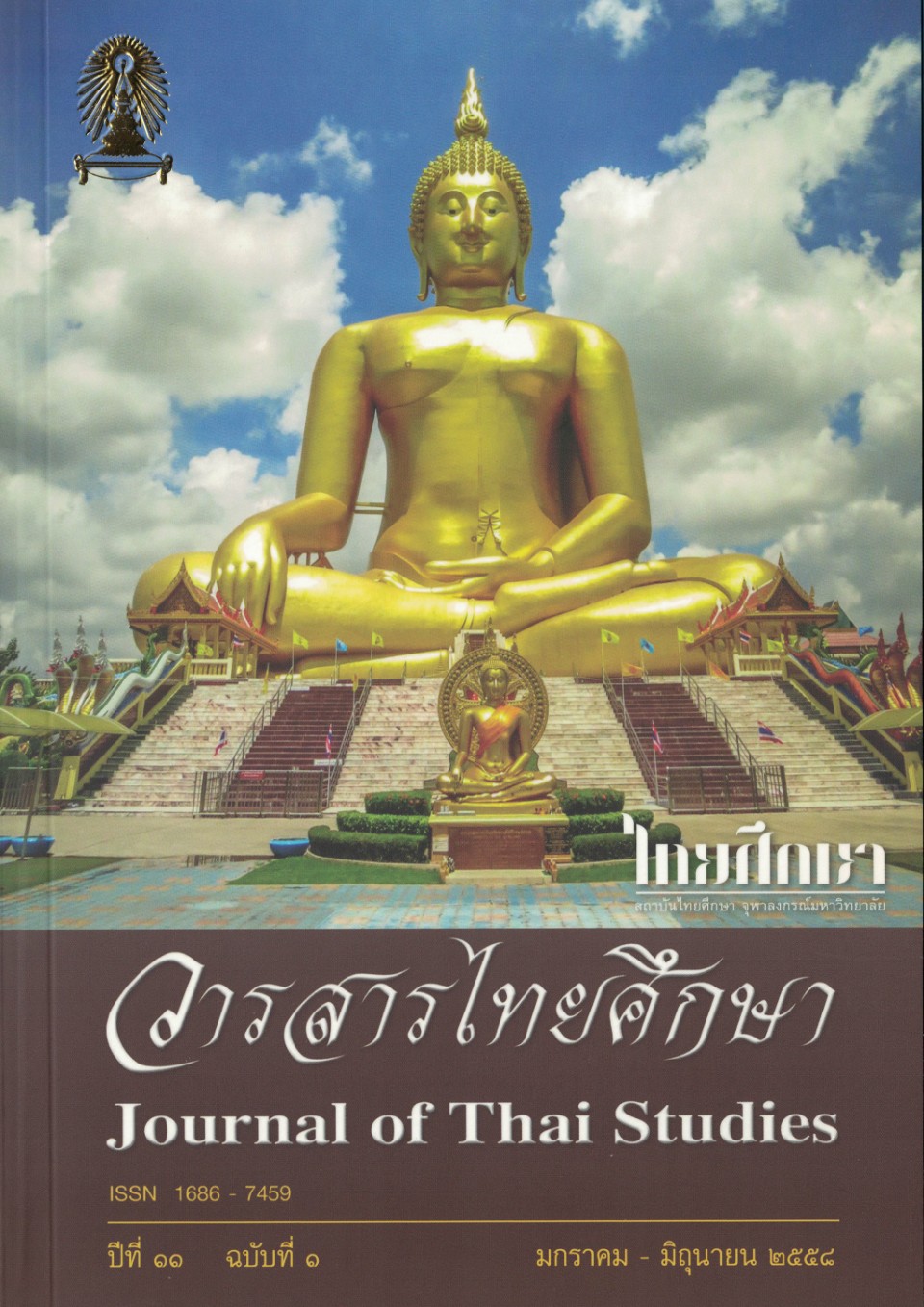The Legend of Phya Kong and Phya Phan: A Trace of Relationship of People in Western Thailand
Main Article Content
Abstract
The Legend of Phya Kong and Phya Phan is a local legend behind the creation of Phra Pathom Chedi. The legend says the relationships of people in the western region are formed through war and kindred families. This article aims to explore the traces of the relationships of people in the western Thailand in the various versions of Phya Kong and Phya Phan legend and to study the values of the this legend in recording history and connecting people in the western part of the country with the collective experience of having “the same legend”. The study found that the Phya Kong and Phya Phan legend derives from Sanskrit literature. In Thailand, several versions are found and can be divided into two storylines: one is a story about the killing of his father which explaines the archeological site of Phra Pathom Chedi; and the another is a story about Princess Usa and Prince Barot. The patricide storyline describes the establishment of Phra Pathom Chedi and the links to related areas, particularly in the western region, including Nakhon Pathom, Kanchanaburi, Ratchaburi and Suphan Buri. These cities are among the major cities in the Dvaravati period where people from other places were forced to settle in later. The relationships found in this legend are both negative and positive, reflecting the conflicts and subsequent compromises in the western region and are integrated with the Buddhist thoughts. The Princess Usa and Prince Barot tale discusses the relationship of the urban areas along the Mekong River and is not tied to any Buddhist concept.
Downloads
Article Details

This work is licensed under a Creative Commons Attribution-NonCommercial-NoDerivatives 4.0 International License.
Journal of Thai studies is licensed under a Creative Commons Attribution-Noncommercial-NoDerivatives4.0 Intenational (CC BY-NC-ND 4.0) licence, unless otherwise stated. Plese read our Policies page for more information on Open Access, copyright and permissions.
References
คณะกรรมการจังหวัดสุราษฎร์ธานี, จังหวัดสุราษฎร์ธานี. กรุงเทพฯ : โรงพิมพ์อุดม, ๒๕๐๐.
ชลดา เรืองรักษ์ลิขิต. พญากง พญาพาน: ตัวละครทีได้ที่มาจากวรรณคดีสันสกฤต. วารสารภาษาและวรรณคดีไทย ปีที่ ๙, ฉบับที่ ๒ (ตุลาคม ๒๕๓๕): ๓๒-๓๘.
ทิพากรวงศ์ (ขำ บุนนาค), เจ้าพระยา. เรื่องพระปฐมเจดีย์. พระนคร : โรงพิมพ์โสภณพิพรรฒธนากร, ๒๔๖๙.
เทพ สุนทรศารทูล. กาพย์พญากงพญาภาณ. กรุงเทพฯ : พระนารายณ์, ๒๕๓๗.
ธิดา สาระยา, “ทวารวดี”: ต้นประวัติศาสตร์ไทย, (กรุงเทพฯ: เมืองโบราณ, ๒๕๔๕), หน้า ๑๐.
บุษย์ รจนา. พระยากง พระยาพาน. พระนคร : โรงพิมพ์ราษฎร์เจริญ, ๒๔๙๓.
พงษ์อนันต์ สรรพานิช. ผจญภัยในตำนานพระยาพาน พระยากง. กรุงเทพฯ : บริษัท ไพลิน บุ๊คเน็ต, ๒๕๔๔.
มนู วัลยะเพ็ชร์ และคณะ, รายงานผลการวิจัยเรื่อง การศึกษาทางภูมิศาสตร์เกี่ยวกับชื่อภูมิประเทศของจังหวัดนครปฐม. นครปฐม: ภาควิชาภูมิศาสตร์ คณะอักษรศาสตร์ มหาวิทยาลัยศิลปากร, ๒๕๒๒.
ลิเกเกียรติยศแห่งสยาม พญากง-พญาพาน แห่งสุวรรณภูมิ ณ โรงละครแห่งชาติ (โรงใหญ่) วันพุธที่ ๒๔ ธันวาคม ๒๕๔๖. กรุงเทพฯ : ศิลปวัฒนธรรม มติชน, ๒๕๔๖.
สุกัญญา ภัทราชัย. พญากง พญาพาน ในเพลงพื้นบ้าน. วารสารเมืองโบราณ ปีที่ ๘ ฉบับที่ ๓ สิงหาคม - พฤศจิกายน ๒๕๒๕.
สุกัญญา สุจฉายา. พิธีกรรม ตำนาน นิทาน เพลง: บทบาทของคติชนในสังคมไทย. กรุงเทพฯ: ศูนย์คติชนวิทยาร่วมกับโครงการตำราคณะอักษรศาสตร์, ๒๕๔๘.
สุจิตต์ วงษ์เทศ. พระปฐมเจดีย์ไม่ใช่เจดีย์แห่งแรกแต่เป็นมหาธาตุหลวงยุคทวารวดี. กรุงเทพฯ: มติชน, ๒๕๔๕.
สุจิตต์ วงษ์เทศ. “ลูกฆ่าพ่อที่เป็นหมา ในนิทานศักดิ์สิทธิ์ วัดพระนอนจักรสีห์ สิงห์บุรี”. มติชนสุดสัปดาห์ ฉบับวันศุกร์ที่ ๑๘ กรกฎาคม ๒๕๕๗
สุจิตต์ วงษ์เทศ. “ลังกา-สิงหล ตำนานลูกฆ่าพ่อ” คอลัมน์ สยามประเทศไทย มติชนรายวัน ๑๗ มกราคม ๒๕๔๘.
ศิราพร ณ ถลาง. ทฤษฎีคติชนวิทยา: วิธีวิทยาในการวิเคราะห์ตำนาน-นิทานพื้นบ้าน. กรุงเทพฯ : ศูนย์คติชนวิทยา คณะอักษรศาสตร์ จุฬาลงกรณ์มหาวิทยาลัย, ๒๕๔๘.
อภิลักษณ์ เกษมผลกูล. กลวิธีเล่าเรื่องชาดกที่เน้นแนวคิดเรื่อง ทานในอรถถกถาชาดาและปัญญาสชาดก ฉบับหอสมุดแห่งชาติ. วารสารภาษาและวรรณคดีไทย ปีที่ ๒๘ (ธันวาคม ๒๕๕๔)
อภิลักษณ์ เกษมผลกูล. “พระวรวงศ์: วรรณกรรมท้องถิ่นที่แสดงร่องรอยความสัมพันธ์ทางภูมิศาสตร์และวัฒนธรรมระหว่างภาคตะวันออก ภาคกลาง และภาคใต้” วารสารมนุษยศาสตร์และสังคมศาสตร์ มหาวิทยาลัยราชภัฏสุราษฎร์ธานี ปีที่ ๔ ฉบับที่ ๒ หน้า ๑๐๔-๑๓๑ ปี ๒๕๕๕.


